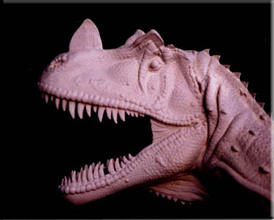Tomografía computarizada del endocráneo de Ceratosaurus

The endocranium of the theropod dinosaur Ceratosaurus studied with computer tomography
Sanders, R. Kent, & David K. Smith, 2005.
Acta Palaeontologica Polonica 50 (3): 601-616
Abstract: A well preserved specimen of the theropod Ceratosaurus has
from the Upper JurassicMorrison Formation of western Colorado was
recently described and given the name C. magnicornis. The systematics
of the genus is outside the scope of the present study but, as a
generally accepted basal tetanuran, the braincase was CT scanned to
provide a description of the endocranium, inner ear, pneumatic, and
venous sinus systems in a primitivemember of this clade. Fivemajor
subregions of the theropod endocranium are distinguished for the
purpose of simplifying cranial computed tomographic interpretation and
to provide a systematic means of comparison to other endocrania. The
skull morphology of Ceratosaurus influences the overall braincase
morphology and the number and distribution of the major foramina. The
low pontine angle and relatively unflexed braincase is considered a
more primitive character. The orientation of the horizontal
semicircular canal confirms a rather horizontal and unerect posture of
the head and neck.As in birds, the narrower skullmorphology of
Ceratosaurus is associated with fewer cranial nerve foramina.
Additionally, the maxillary dominated dentigerous upper jaw of
Ceratosaurus is felt to share with the alligator a large rostrally
directed maxillary division of the trigeminal nerve and a small
ophthalmic branch. The upper bill of birds, being dominated by the
premaxillary and lacking teeth, is innervated predominantly by the
ophthalmic division of the trigeminal nerve. For this reason,
avian−based cranial nerve reconstructions are felt to be inappro−
priate for basal theropods. Ceratosaurus skull pneumatization and
possible evidence of olfactory conchal structures is on the other hand
very avian in character. Based on computed tomography, Ceratosaurus is
determined to have possessed a typical basal theropod endocranium and
bipedal vestibular system similar to Allosaurus.













<< Home